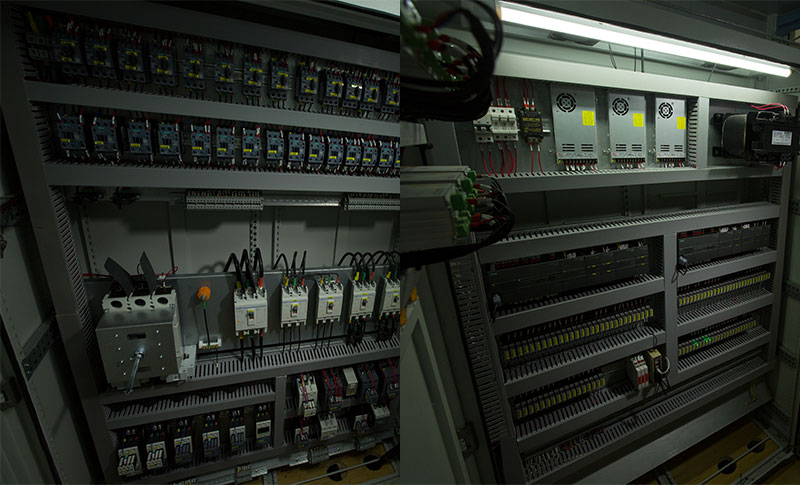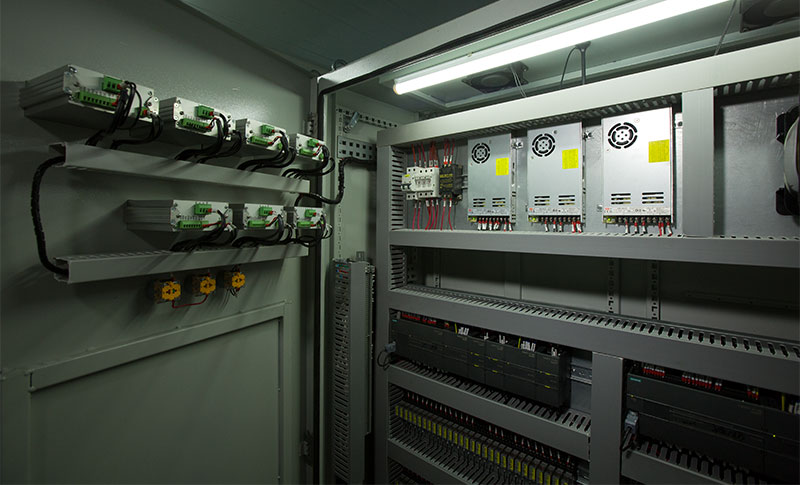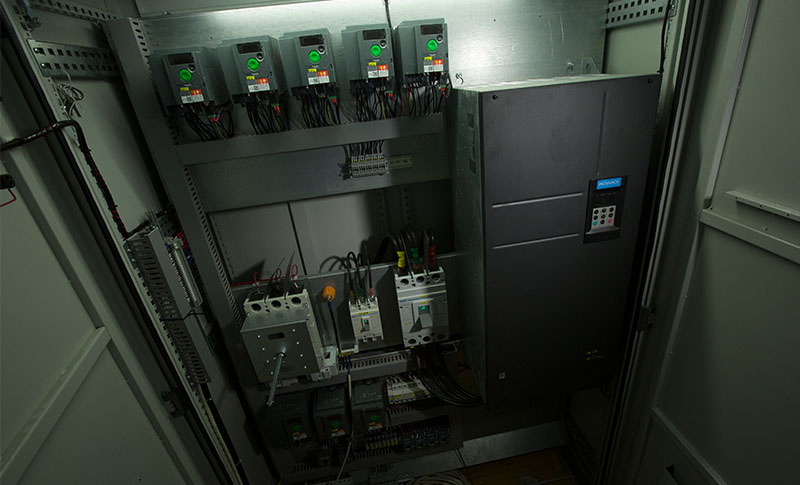Asphalt mixing plants are critical equipment in road construction. The rationality and stability of their power supply systems are directly related to production efficiency, product quality, and operational safety. To ensure continuous production of asphalt mixtures, strict control must be exercised in terms of power supply stability and capacity matching.
Voltage Fluctuation Permitted Range
According to national power supply standards, voltage fluctuations in asphalt mixing plants should be controlled within ±5%. Excessive voltage can cause motor overheating and insulation damage, while excessively low voltage can cause equipment startup difficulties and reduced operational efficiency. Therefore, power supply departments should install voltage stabilization devices to ensure that the main engine and key equipment operate at rated voltage.
Frequency Deviation Control Standards
The power system frequency should be stable within the range of 50Hz ± 0.2Hz. Frequency fluctuations can affect the stability of the mixing plant’s motor speed, leading to abnormal mixing cycles and uneven mixing quality. For variable frequency drive equipment requiring higher precision, strict monitoring of the power supply frequency is even more crucial.
Three-Phase Unbalance Limits
The three-phase current or voltage imbalance must not exceed 2%. Excessive imbalance can cause motor overheating, reduced efficiency, and even winding burnout. Therefore, asphalt mixing plants must utilize three-phase balanced power distribution and regularly monitor the load balance of the power supply lines.
Core Production Equipment Power Calculation Methods
The total load should be calculated based on the rated power of major equipment such as the main mixer, drying drum, burner, and elevator, taking into account the additive effect of starting current.
Additional Considerations for Auxiliary System Power Loads
In addition to core equipment, the power demands of control systems, lighting systems, dust removal systems, and conveying systems must also be taken into account. Although auxiliary systems have relatively low power requirements, their continuous operation characteristics cannot be ignored.
Peak Power Reserve Design Standards
To ensure power supply security during peak production or when equipment is started simultaneously, the power supply capacity should include a 15%-20% margin on top of the total calculated load.

Asphalt mixing plants are categorized by installation method: fixed and mobile. Due to their varying usage scenarios, equipment layouts, and operating modes, their power supply requirements differ significantly, requiring targeted design and configuration.
Fixed asphalt mixing plants are often located in fixed plant locations. They have long operating cycles and large equipment scale. Their power supply systems must meet long-term stability and high capacity requirements, adhering to strict installation and selection specifications.
Permanent Power Line Installation Specifications
Fixed/stationary asphalt mixing plants are typically powered by high voltage. High-voltage lines should be laid overhead or in cable trenches. The cross-sectional area of overhead line conductors must be selected based on the load current, and the insulation grade must be no less than 10kV. Low-voltage lines are preferably laid in cable trenches, using copper-core cross-linked polyethylene insulated cables. The cross-sectional area should be calculated based on the current carrying capacity, with an additional level of margin added. The line routing must avoid areas of equipment vibration and high temperatures. Drainage and fire separations should be installed in the cable trenches, and inspection wells should be located every 50 meters to ensure line safety, reliability, and ease of maintenance.
Transformer Capacity Selection Basis
Transformer capacity selection should be based on the total power load of the mixing station, taking into account the load characteristics and operational features. First, calculate the total calculated load (the calculated power of the core equipment and auxiliary systems plus the peak reserve). Then, calculate the transformer’s apparent power based on the load power factor (usually 0.85-0.9). The formula is: Transformer apparent power = total calculated load ÷ power factor. For example, if the total calculated load is 900kW and the power factor is 0.9, the transformer’s apparent power is approximately 1000kVA. When selecting a transformer, a 1250kVA transformer should be selected, leaving a 25% margin to accommodate future equipment expansion or load growth.
Workshop Power Distribution System Layout Standards
The workshop power distribution system should adopt a zoned distribution model, divided into distribution units based on equipment function, such as mixing area, drying area, and screening area. Each unit should have an independent distribution cabinet. The power distribution cabinet should be installed in a well-ventilated, dry, and clean area, at least 1.2 meters above the ground, with an access aisle at least 1.5 meters wide. The power distribution circuit should utilize a radial power supply system to ensure independent power supply to each device and prevent a single device failure from impacting operations in other areas. The power distribution cabinet should also be equipped with protective devices such as main circuit breakers, branch circuit breakers, and leakage protection devices. Each circuit should be clearly labeled for easy operation and troubleshooting.
Mobile asphalt mixing plants must be relocated with construction projects, requiring flexible operation locations and short installation cycles. The power supply system must meet temporary, portable, and emergency requirements, and its configuration and protection must be tailored to the specific needs of mobile applications.
Temporary Power Supply Configuration Principles
Mobile asphalt mixing plants should preferably be connected to a nearby industrial power source. If a stable industrial power source is unavailable at the construction site, a diesel generator must be used as the primary power source. The generator capacity should be 20%-30% larger than the total calculated load of the mixing plant to accommodate startup loads and load fluctuations. A main distribution box with overload, short-circuit, and leakage protection must be installed at the power access point and located no more than 50 meters from the mixing plant equipment. When using dual power sources (industrial power + generator), an automatic power switching device must be installed to ensure that the power switching process does not affect equipment operation.
Cable Dragging Protection Technical Requirements
Mobile concrete mixing plants require frequent drag and movement of cables. Therefore, heavy-duty rubber-sheathed cables that are wear-resistant, oil-resistant, and stretch-resistant must be used. The cable cross-sectional area should be increased by one level based on the current carrying capacity, and the insulation thickness should be at least 2.5mm. Cables should be laid in cable protection troughs or overhead to prevent abrasion caused by direct drag on the ground. When crossing roads or equipment passages, metal protective conduits should be used for protection, with both ends of the conduit extending at least 1 meter beyond the edge of the passage. Cable joints should use waterproof seals to ensure insulation performance in humid and dusty environments. Regularly inspect the cable’s appearance and insulation resistance, and replace any damage promptly.
Emergency Power Supply Switching Device Standards
The emergency power supply switching device is critical to ensuring the continuous operation of the mobile concrete mixing plant. Its switching time must be controlled within 0.5 seconds to prevent power outages and other losses such as mixture solidification. The switching device should have both manual and automatic switching modes. In automatic mode, the voltage monitoring module monitors the main power status in real time. If the main power voltage drops below 85% of the rated value or a power outage occurs, the backup power source is immediately activated. Furthermore, the switching device must be linked to the concrete mixing plant control system. During the switching process, power to key equipment such as the mixing main unit and burner is prioritized, and auxiliary equipment is restored only after the power stabilizes.
Motor Starting Current Control Standards
The main unit motor has high power, and the starting current is typically 5-7 times the rated current. A soft start or variable frequency starting device should be used to avoid impact on the power grid.
Power Supply Stability Requirements for Variable Frequency Speed Control Systems
VFDs are sensitive to voltage and frequency. They must provide a stable, harmonic-free power supply and be equipped with a filter.
Overload Protection Parameter Setting Specifications
The overload protection value should be set at 1.1-1.2 times the motor’s rated current to prevent motor burnout due to overload operation.
Power Supply Ratings for Drying Drum Drive Motors
Drying drums operate continuously and under heavy load, so a heavy-duty motor is required. The power supply system must ensure stable voltage to avoid fluctuations.
Power Supply Safeguards for the Burner Ignition System
The ignition system is extremely sensitive to power fluctuations. A separate, stable power supply should be provided, along with a UPS.
Temperature Control System Power Supply Anti-Interference Requirements
Temperature control instruments and sensor circuits must be shielded and grounded to prevent electromagnetic interference from affecting measurement and control accuracy.
Vibrating Screen Motor Power Supply Phase Requirements
Vibrating screens are often driven by dual motors, which must be phase-aligned to ensure the correct direction of the excitation force.
Bucket Elevator Start-Stop Power Supply Protection Standards
Elevators that frequently start and stop should be equipped with thermal relay protection to prevent motor overheating or overload damage.

Ground Resistance Value Control Standards
Ground resistance should be ≤ 4Ω to ensure rapid discharge of leakage current and prevent electric shock accidents.
Leakage Protection Device Installation Specifications
All power distribution circuits must be equipped with leakage protection devices (RCDs). The operating current must not exceed 30mA and the operating time must be less than 0.1 second.
Electrical Equipment Selection Requirements for Explosion-Proof Areas
In explosion-proof areas such as burners and oil storage, electrical equipment that meets explosion-proof ratings must be used.
High-Temperature Environment Cable Heat Resistance Standards
Specialized cables with a temperature resistance of ≥ 125°C should be used around drying drums.
Electrical Sealing Protection Requirements for Dust Environments
Electrical components with a protection rating of IP65 or higher should be used in screening and silo areas.
Insulation Performance Assurance Measures for Humid Environments
During the rainy season or at humid construction sites, all cable joints must be equipped with waterproof seals to ensure an insulation resistance of ≥ 1MΩ.
Backup Power Supply Switchover Time Limit
ATS switchover time should be ≤ 10 seconds to ensure uninterrupted mixing processes.
Emergency Lighting Power Supply Duration Standard
Emergency lighting power supply should last at least 90 minutes to ensure safe evacuation and maintenance during a power outage.
Emergency Power Supply Priority for Key Equipment
The mixing unit, burner, and control system should be prioritized; restoration of other equipment may be delayed.
On the basis of ensuring stable and secure power supply, optimizing the power supply system through energy-saving configurations and intelligent monitoring can not only reduce energy costs but also improve operation and maintenance efficiency, meeting the requirements of green production and intelligent development.
Reactive Power Compensation Device Installation Specifications
To improve the power factor, automatic compensation capacitor cabinets should be installed to achieve a power factor ≥ 0.9.
High-Efficiency and Energy-Saving Motor Power Supply Adaptation Standards
Core motors should use IE3 or higher energy efficiency ratings to reduce energy consumption.
Real-Time Power Load Monitoring System Configuration
Smart meters and monitoring systems should be installed to enable real-time data collection on voltage, current, and power factor.
Power Supply Fault Warning Signal Transmission Requirements
The system should have remote warning capabilities to promptly report voltage drops, frequency anomalies, overloads, and other conditions.

The power supply system must pass safety inspections by the power department and the industry to ensure compliance with national power regulations and industry safety standards. It may only be put into operation after passing these inspections.
Required Conditions for Power Supply Plan Approval
Before building a concrete mixing plant, a power supply plan, including capacity calculations, load distribution, and a circuit diagram, must be submitted to the power department for approval.
Metering Device Installation Specifications
Electricity meters must be installed in designated locations and equipped with remote meter reading capabilities.
Required Items in the Electrical System Inspection Report
This report should include test results for insulation resistance, ground resistance, leakage protection operation tests, and load trials.
Special Equipment Power Supply Interconnection Acceptance Standards
Special equipment such as drying drums and burners must undergo power supply interconnection testing to ensure power supply reliability and safety.
Power supply for asphalt mixing plants is not just about energy security; it is also a prerequisite for production efficiency, safety, and quality. From power supply stability and capacity matching to the differentiated needs of different site types, and finally to specialized equipment requirements and energy efficiency optimization, every aspect must strictly adhere to standards. Only through scientific design, reasonable configuration, and standardized acceptance can an asphalt mixing plant ensure long-term, safe, and stable operation in a high-intensity construction environment.